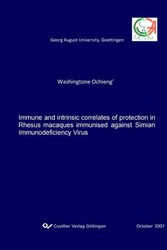| Areas | |
|---|---|
| Serie de libros (96) |
1378
|
| Nachhaltigkeit |
3
|
| Gesundheitswesen |
1
|
| Letra |
2364
|
| Ciencias Naturales |
5406
|
| Matemática | 229 |
| Informática | 319 |
| Física | 980 |
| Química | 1363 |
| Geociencias | 131 |
| Medicina humana | 243 |
| Estomatología | 10 |
| Veterinaria | 108 |
| Farmacia | 147 |
| Biología | 835 |
| Bioquímica, biología molecular, tecnología genética | 121 |
| Biofísica | 25 |
| Nutrición | 45 |
| Agricultura | 1004 |
| Silvicultura | 201 |
| Horticultura | 20 |
| Ecología y conservación de la tierra | 148 |
| Ciencias Ingeniería |
1793
|
| General |
98
|
|
Leitlinien Unfallchirurgie
5. Auflage bestellen |
|
Erweiterte Suche
Immune and intrinsic correlates of protection in Rhesus macaques immunised against Simian Immunodeficiency Virus (Tienda española)
Washingtone Ochieng' (Autor)Previo
Indice, Datei (49 KB)
Lectura de prueba, Datei (190 KB)
Efficacy assessment of AIDS vaccines relies both on pre-clinically challenging immunised monkeys with a pathogenic virus and subsequent monitoring of infection rates in large human trials. Conventional parameters of vaccine-induced immune responses do not completely predict outcome. Moreover, existing methods for testing cellular immunity are sophisticated and difficult to establish in resource-limited settings, thereby constraining large studies. There is a need for study models that bridge the gap between preclinical and clinical vaccine testing, and which are able to predict a virus-specific vaccine effect before actual challenge. Virus replication kinetics (VVR) on ConA-stimulated peripheral blood mononuclear cells (PBMC) was used as an ex vivo model to mimic the interaction between different components of the immune system and viral infection. PBMCs were obtained from the 17 experimental rhesus monkeys before immunisation and subsequently at 12, 26 and 44 weeks during immunisation (wdi). Before immunization, VVR of vaccine-naïve PBMCs varied between individual animals by between >430-fold and >60-fold after 7 and 10 days of infection cultures. VVR of sham-vaccinated control monkeys remained constant over 44 the weeks. However, VVR of immunised animals was significantly attenuated during this follow-up period. This effect was not influenced by the MHC- class 1 Mamu-A*01 allele, which is normally associated with slow disease progression. VVR was instead dependent on the number of IFNγ-producing cells (p=0.001), CD8+ T-cell non-cytotoxic antiviral response (CNAR) (p=0.01) and MIP-1α (p=0.013). High VVR correlated with increased CXCL10, IL-1β and MIP-1β. Importantly, pre-challenge VVR, CXCL10, IL-1β and MIP-1β but not IFNγ correlated directly with acute plasma viremia and inversely with memory CD4+ T-cell counts after SIVmac239 challenge. VVR was thus able to predict disease progression and the protective capacity of the vaccine regime. Likewise, pre-challenge CNAR, MIP-1α and IL-10 were associated inversely with acute-phase plasma viremia and directly with memory CD4+ T-cell concentrations in blood. When applied to human studies, this ex vivo infection technique could predict the efficacy of candidate AIDS vaccines prior to phase III clinical trials.
| ISBN-10 (Impresion) | 3867274274 |
| ISBN-13 (Impresion) | 9783867274272 |
| ISBN-13 (E-Book) | 9783736924277 |
| Formato | A5 |
| Idioma | Inglés |
| Numero de paginas | 148 |
| Edicion | 1 Aufl. |
| Volumen | 0 |
| Lugar de publicacion | Göttingen |
| Lugar de la disertacion | Göttingen |
| Fecha de publicacion | 22.11.2007 |
| Clasificacion simple | Tesis doctoral |
| Area |
Matemática
Biología |
| Palabras claves | HIV, Immune response, Immunisation, Protection, Suspectibility. |








